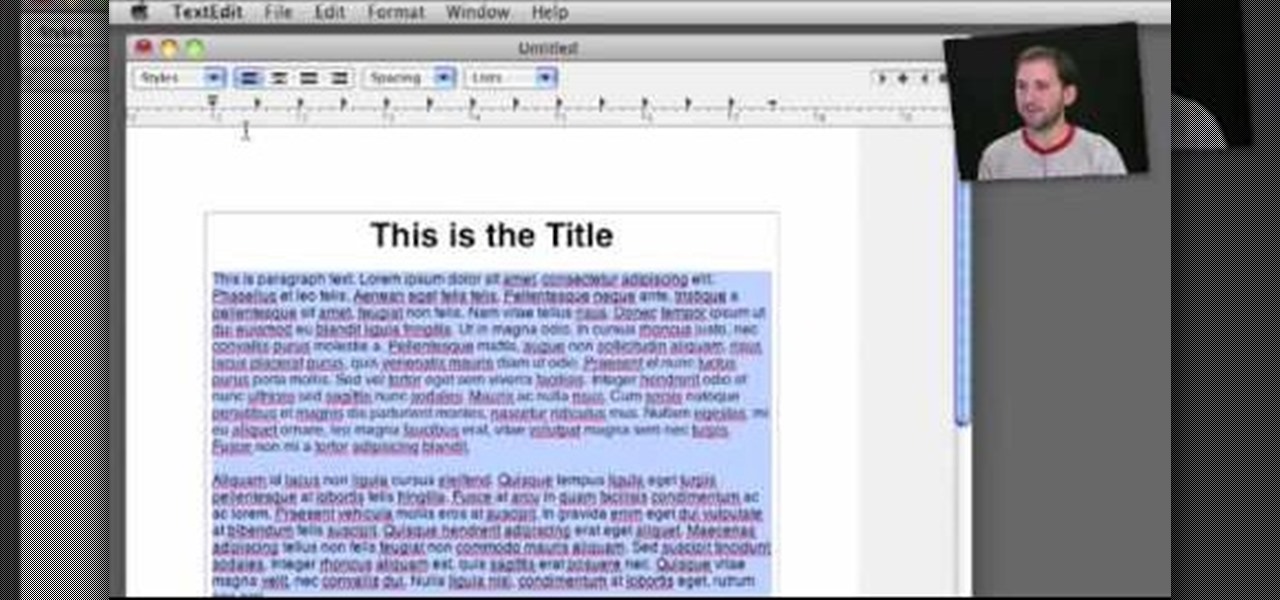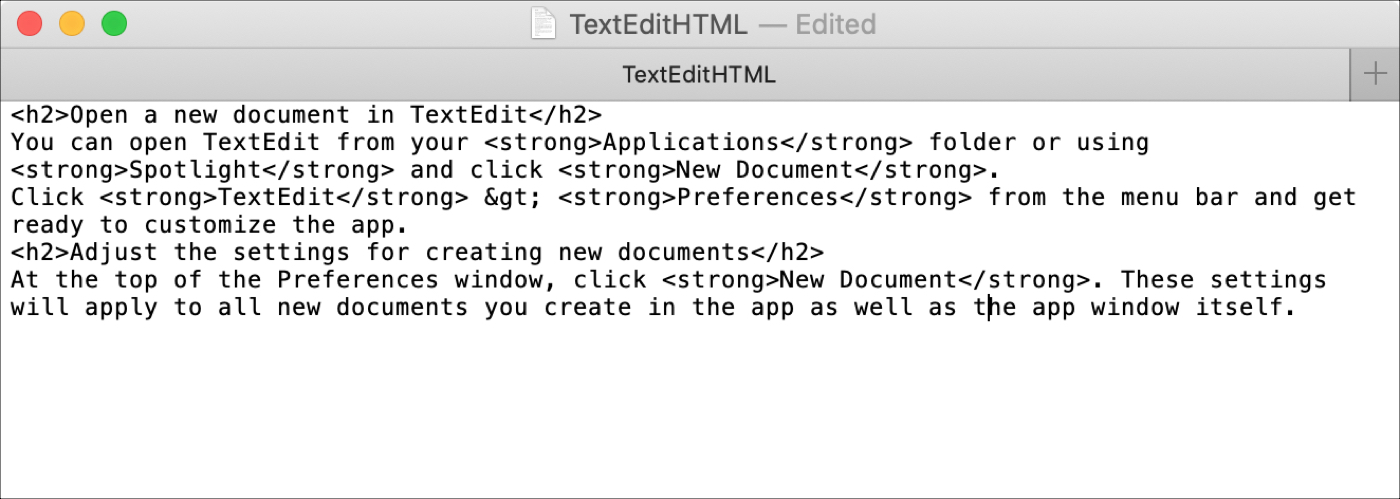- New Mac users may not know about TextEdit, a simple but deep text editing and word processing tool that comes with your Mac.
- Printing from TextEdit sometimes seems like a black art—often the font size of your printed document will be much smaller than the font size used in the onscreen original.
- In order to retrieve some important deleted TextEdit files on Mac, FoneLab Data Retriever is a safe and convenient TextEdit Recovery on Mac to get back deleted/lost/formatted files with ease. Moreover, it is able to retrieve deleted or unsaved files from hard drive, flash drive, digital camera, memory card and more.
Create an HTML File in TextEdit. If you only occasionally work on HTML files, you can make the change to plain text for a single document. Open the TextEdit application on your Mac. Select File New from the menu bar. Select Format on the menu bar and click Make Plain Text. TextEdit is a free word processor that has long been included as part of Macintosh operating systems (it was originally created for the NeXTSTEP operating system and came to Apple as part of the.
Good question. Coda is everything you need to hand-code a website, in one beautiful app.
- TextPad for Mac OS X, download best alternative solutions carefully chosen by our editors and user community. Windows Mac Android ForMac. Bean is a text editor that can save and open in a useful set of formats: bean, rtf, rtfd, doc, docx, odt, and webarchive. It is essentially a more powerful version of TextEdit, with a.
- TextEdit is a word processor/text editor in Mac OS X Lion that you can use to write letters, scribble notes, or open Read Me files. It’s not as sophisticated as Microsoft Word (or Apple’s Pages, Quark Xpress, or Adobe InDesign, for that matter), but you can definitely use OS X Lion’s TextEdit for light word-processing and text editing.
While the pitch is simple, building Coda was anything but. How do you elegantly wrap everything together? Well, we did it. And today, Coda has grown to be a critical tool for legions of web developers around the world.
Free Mac Text Editor
Textmate is state of the Art editor, but if someone is thinking about developing on several platforms without awkward memory eaters monsters like jedit, eclipse, netbeans etc take a look at geany (geany.org). The only problem the editor has not esthetic look and feel on Mac OS X:).
More than anything else, Coda is a text editor. It’s got everything you expect: syntax highlighting for tons of languages. Code folding. Project-wide autocomplete. Fast find and replace. Indentation guides. Automatic tag closing. Fast commenting and shifting of code. The works. But Coda’s editor has features you won’t find anywhere else. For example, the Find and Replace has this revolutionary 'Wildcard' token that makes RegEx one-button simple. And as you type, Coda Pops let you quickly create colors, gradients, and more, using easy controls. There are nice touches everywhere.
But an incredible text editor is just a nice typewriter if you can’t easily handle all of your files — from anywhere. Coda has battle-tested, deeply integrated file management. Open local files or edit remotely on FTP, SFTP, WebDAV, or Amazon S3 servers. Use the Files tab and move, rename, copy, transfer from server-to-server... anything. Track local changes for remote publishing. There’s even support for Git and Subversion.
Then you’ll want to see what your code looks like. Use our WebKit Preview, which includes a web inspector, debugger, and profiler. Then, on top of that, we added AirPreview, a revolutionary feature that lets you use your iPad and iPhone with Code Editor to Preview pages as you code on your desktop.
Believe it or not, we’ve just scratched the surface. Open Coda’s Sidebar to discover a rich set of utilities that make you work better. Like Clips, which let you create frequently used bits of text that you can insert into your document with special triggers. And project-wide Find and Replace that’ll work across multiple files. There’s also an HTML Validator, a Code Navigator, and more.
Best Macos Text Editor

Finally, hiding behind the Plus button in the tab bar is a built-in Terminal and MySQL editor, two amazingly powerful Tab Tools. The Terminal can open a local shell or SSH. MySQL lets you define structure, edit data, and more.
And it’s all wrapped up in our Sites, which get you started quickly. Opening a Site sets your file paths, your root URLs, where your files Publish to, source control settings, and more. And with Panic Sync, our free and secure sync service, your sites follow you on any computer.
Coda is a very good app.
Convert rich text documents to other formats
With TextEdit, you can open and edit rich text documents created in other word processing apps, including Microsoft Word and OpenOffice. You can also save your documents in a different format, so they’re compatible with other apps.
Create and edit HTML documents
You don’t need a special app to write or edit HTML code—just use TextEdit. You can display HTML documents like you’d see them in a browser, or use TextEdit as a code editor.
Mark up images
You can write or draw on images in your text files using the tools in the Markup toolbar.
To browse the TextEdit User Guide, click Table of Contents at the top of the page.
Home > Articles > Apple > Operating Systems
New Mac users may not know about TextEdit, a simple but deep text editing and word processing tool that comes with your Mac. You can use TextEdit to create documents in cases when a full word processor like Pages or Microsoft Word isn't necessary. TextEdit has two modes: plain text and rich text. You can use the first for writing, notes and coding.
␡- Create and Save a TextEdit Document
TextEdit, one of the stock applications for the Mac, might be coming to the iPhone, iPad and iPod touch, suggests an icon spotted on an iPad during one of the WWDC 2016 demos. As first discovered by MacRumors, the “What’s New in Metal, Part 1” WWDC session video shows (mark 17:58) a TextEdit icon on the iPad’s multitasking app switcher. TextEdit is a Mac OS X based open source word processor and text editor which comes installed with Mac distributions. TextEdit was a replacement for the old text SimpleText application and is also used with Unix and Linux operating systems. Mac OS X Lion TextEdit for Windows is a Mac style text editor for Windows which is designed to be an alternative to the Windows default Notepad program. To get the default UI behavior, using the Mac built-in open command, with that '-a TextEdit' flag (that others mentioned) induces the Mac UI to have (any) currently running instance of TextEdit handle the call (with no inapropos 'sudo' needed for general case usage). TextEdit is a simple, open-source word processor and text editor, first featured in NeXT's NeXTSTEP and OpenStep. It is now distributed with macOS since Apple Inc. 's acquisition of NeXT, and available as a GNUstep application for other Unix -like operating systems such as Linux.


This chapter is from the book
This chapter is from the book
TextEdit is a small yet surprisingly powerful word processor. Use it to write memos, letters, diaries, novels, grocery lists, memoirs, or any other text document. You can create simple tables and automatically numbered or bulleted lists, add shadows to type, insert images, search and replace text, and more. But it’s not a full-blown word processor such as Apple’s Pages (check the App Store in your Dock) or MarinerWrite (MarinerSoftware.com) or the sweet, new Pagehand (Pagehand.com). Although TextEdit can’t do all the fancy things a big word processor can, it’s excellent for many projects.
If you’ve never used a word processor before and you don’t know how to open an application and save files, enter text, select text for formatting, cut/copy and paste, etc., please read The Little Mac Book first! This chapter assumes you know the basics of working in a word processor.
Create and Save a TextEdit Document
Open TextEdit (it’s in your Applications folder and in Launchpad). Then from its File menu, choose “New.” A blank window opens for you to start typing.
Choose how you want to see the document: From the Format menu, choose “Wrap to Window” (below, left) or “Wrap to Page” (below, right).
Save your document as usual (from the File menu, choose “Save..” give it a name, and store it in a folder where you’ll find it again). As you continue to work on your TextEdit document, an “Edited” button appears in the top-right corner of the document window. This is a visual clue that the document has been changed and you might want to save the changes (press Command S). Sylenth 1.8 download.
You can click that “Edited” button or triangle to choose from several options:
Textedit Macos Mojave
- Lock prevents further changes. If you try to type, you get an option to Unlock it. This is not a secure lock—anyone can click the Unlock button.
- Revert to Last Saved Version gives you the option to revert to the last time it was saved (either by you or by TextEdit), or you can revert to an older version, as explained on the opposite page.
- Browse All Versions—see the opposite page.
AutoSave and versions
How To Use Textedit Mac
TextEdit automatically saves your document every hour as you work on it, as well as when you close it (it doesn’t ask—it just saves). In addition, you can (and should) save more often (press Command S).
As soon as you save and name a document, TextEdit keeps track of all previous versions of that document; that is, every time you save or TextEdit saves, a new version is stored. You can return to any of these versions, as explained below.
To manually save the current version, go to the File menu and choose “Save a Version,” or press Command S.

Textedit Macbook App
To save a document with another name or in another file format, go to the File menu and choose “Duplicate.” Save this new file with a new name.
Restore a previous version
Macbook Textedit Html
To turn to a previous version of the document, click the top-right corner to get the menu shown below. Choose “Browse All Versions..” All previous versions of your document appear, as shown at the bottom of this page.
Click on the title bars to go back in time to previous versions, or click in the vertical timeline to view various versions. When you find the one you want, click the “Restore” button at the bottom of the screen.
Textedit For Mac Os High Sierra
Related Resources
Textedit Application
- Book $55.99
- eBook (Watermarked) $55.99
How To Open Textedit Mac
Textedit App Mac
- Web Edition $55.99